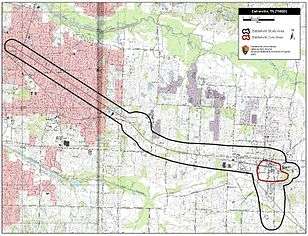Battle of Collierville
| ||||||||||||||||||||||||||||
The Battle of Collierville (November 3, 1863), also known as the Second Battle of Collierville, was a battle in the Western Theater of the American Civil War.
Background
Four minor battles occurred in 1863 at Collierville, during a three-month period. The two largest battles occurred on October 11 and November 3, 1863. The battle on October 11 was the largest land battle fought in Shelby County, Tennessee.
Battle

The battle on November 3 was intended to be a Confederate cavalry raid to break up the Memphis & Charleston Railroad behind Sherman's Fifteenth Army Corps, then in the process of marching to the relief of Chattanooga. But, when Confederate Brig. Gen. James Chalmers, leading a cavalry division riding up from Mississippi, learned that only one Union regiment was left to defend Collierville, he decided to attack. Chalmers supposed Union Colonel Edward Hatch possessed fewer men stationed at Collierville and at Germantown, five miles (8 km) to the west, than he actually did. Hatch's scouts warned him of Chalmers's approach from the south, so he ordered Collierville's defenders to be prepared and rode from Germantown with cavalry reinforcements.
General Chalmers, as he had done only three weeks earlier, attacked from the south with McCulloch's and Slemon's brigades. The Union garrison was defended by eight companies of the 7th Illinois Cavalry Regiment and two howitzers. Col. Hatch quickly arrived with the 6th Illinois and 2nd Iowa Cavalry Regiments. The Confederates launched an attack with only part of Slemon's brigade, believing faulty intelligence that it was lightly defended. The Union 2nd Regiment Iowa Volunteer Cavalry opened fire with their repeating Colt revolver rifles and repulsed the attack. Surprised by the unexpected appearance of the enemy on his flanks, Chalmers concluded that he was outnumbered, called off the battle, and, to ward off Union pursuit, withdrew back to Mississippi. Chalmers reported the loss of 6 killed, 63 wounded, 26 prisoners, including Colonel James Z. George, commanding the 5th Mississippi Cavalry. Hatch reported the loss of approximately 60 casualties. The Memphis & Charleston Railroad remained open to Tuscumbia, Alabama, for Union troop movements.
See also
References
- Rowland, Dunbar & Howell, H. Grady, Jr., "Military History of Mississippi, 1803-1898", Chickasaw Bayou Press, 2003, Library of Congress Number 2002117732
Further reading
- Smith, Timothy B. (2012). James Z. George: Mississippi's Great Commoner. Jackson: University of Mississippi Press. ISBN 978-1-61703-231-8.